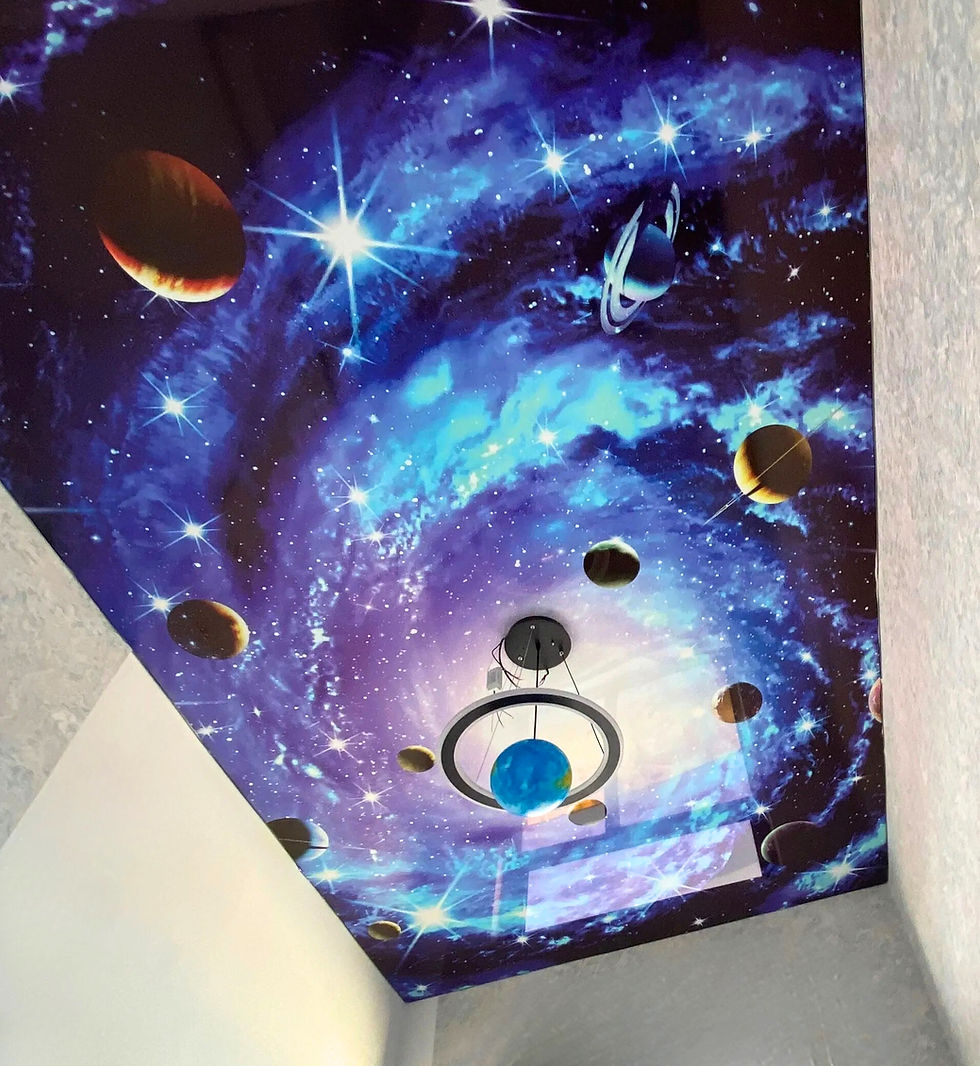Stretch Ceiling Maintenance and Cleaning Guide
- info5008746
- Oct 1
- 7 min read
Keeping your home looking fresh and modern starts from the top. If you’ve installed a stretch ceiling, you already know how it transforms a room. These sleek, low maintenance surfaces are durable, stylish, and built to last. However, like any surface in your home, they need occasional cleaning to preserve their appearance and ensure longevity.
In this complete guide, you’ll learn how to clean your stretch ceiling correctly using gentle techniques, safe products, and practical routines. Whether your ceiling is matt, satin, gloss, or custom printed, we’ll walk you through care methods that keep it looking pristine. You’ll also find expert advice on maintenance tips, stain removal, water sagging, and when to call a professional.
Let’s explore everything you need to know to keep your stretch ceiling spotless and smooth for many years to come.

Why Proper Maintenance Matters
Your stretch ceiling is a design investment, not just a finishing touch. These membranes are tensioned and engineered to stay taut, providing a flawless surface for decades. However, even though they resist dust, moisture, and ageing, some simple care is essential.
Without light maintenance, tiny layers of dust, cooking residue, or moisture can settle on the surface, especially in kitchens or bathrooms. Over time, these can dull the finish, affect reflectivity on gloss surfaces, or leave faint patches on matt and satin designs. Fortunately, the solution is simple: gentle, regular cleaning.
Proper care also preserves your warranty. Many installers require routine upkeep using pH-neutral cleaning products to maintain the guarantee. By following recommended methods, you’ll avoid voiding coverage or damaging the membrane.
In short, cleaning your ceiling is less about effort and more about preservation. Ten minutes with a soft cloth every few months keeps it looking brand new.
Understanding Stretch Ceiling Materials and Finishes
Different finishes require slightly different care techniques. Understanding your surface will help you choose the correct products and tools.
PVC Stretch Ceilings
All stretch ceilings installed by Stretch Ceilings and Walls are made from high-quality PVC, a non-porous material that resists moisture and dust. This makes cleaning quick and straightforward. You’ll never need to repaint or sand, and regular light cleaning is all it takes to maintain a perfect finish.
Finish Types
Matt Finish: Soft and classic, ideal for modern minimalism. Clean evenly to avoid visible streaks.
Satin Finish: A delicate sheen that reflects light subtly. Ensure even strokes for consistent shine.
Gloss Finish: High reflection that shows fingerprints and streaks easily. Always dry with a clean microfibre or chamois cloth.
Printed and Custom Designs: Whether it’s a galaxy for a child’s room or a cloud print in a nursery, avoid harsh pressure. Light wiping maintains image quality.
Every finish shares one rule: gentle cleaning and pH-neutral solutions.

Safety and Guarantee Considerations
Before cleaning, review your care instructions from Stretch Ceilings and Walls.
We recommend:
Avoid abrasive tools: No scrubbing pads, steel wool, or rough sponges.
No solvents or bleach: These can degrade the membrane or cause discolouration.
Avoid ammonia-based glass cleaners: Especially for printed or coloured designs.
Do not over-wet the surface: Stretch ceilings are waterproof but not designed for soaking.
Following these guidelines helps you maintain your ceiling’s condition and protects your 15-year guarantee.
Tools, Cloths, and Cleaning Products Checklist
Before cleaning, prepare a simple kit:
Microfibre cloths: Soft and lint-free for all finishes.
Feather duster: For quick dust removal in large areas.
Spray bottle: For gentle misting with diluted solution.
pH-neutral detergent: A drop of mild washing-up liquid in warm water works perfectly.
Chamois cloth: Especially useful for gloss finishes to avoid streaks.
Step ladder: For high ceilings; never lean or press against the membrane.
Having the right tools makes the process smooth and safe, protecting your ceiling from scratches or stains.

Routine Dusting and Light Upkeep
Routine cleaning is quick and easy. For most households, a light dusting every 2–3 months is all you need. Use a feather duster or dry microfibre cloth to sweep the surface gently. Avoid pressing too hard; the membrane should never be pushed or stretched.
If you notice a small mark or fingerprint, dampen your cloth slightly with lukewarm water mixed with a tiny amount of pH-neutral soap. Wipe gently in a circular motion, then leave it to air dry.
For printed ceilings, always dab rather than scrub. This prevents any disturbance to the printed layer or protective coating.
Deep Cleaning by Finish
Different finishes respond differently to moisture and wiping methods. Here’s how to handle each one safely.

Matt Stretch Ceilings
Matt surfaces are forgiving but can show water marks if not cleaned evenly. Spray a small amount of diluted soap solution onto a microfibre cloth (not directly onto the ceiling). Wipe in consistent, overlapping circles. Once complete, go over the surface with a clean, damp cloth to remove any soap residue. Air dry naturally.

Satin Stretch Ceilings
Satin finishes reflect soft light, so streaks can be noticeable. Clean with long, straight motions rather than circular ones. Use two cloths: one damp with soap solution, and one dry to remove moisture and avoid streaks.

Gloss Stretch Ceilings
Gloss ceilings act like mirrors. To keep them sparkling, wipe using a slightly damp cloth with a pH-neutral cleaner, followed immediately by a dry microfibre or chamois cloth. Work in straight lines, following the direction of light. Never leave water to air dry on gloss finishes, it can leave spots or dull the shine.
Cleaning Printed and Custom Designs
Printed designs are beautiful focal points, but they require care. The ink and image layers are sealed under a protective finish but should not be scrubbed or soaked.
To clean, spray your cloth (not the ceiling) with a mild solution and wipe gently using minimal pressure. Always test a small, hidden area first. For smudges or grease, use a fresh cloth and avoid repeated rubbing over the same spot.
If your ceiling features special effects like starry skies or metallic finishes, follow the same process but avoid moisture near light fittings or fibre optics.

High-Use Areas: Kitchens and Bathrooms
Kitchens, bathrooms, and utility rooms experience more moisture, heat, and airborne residue. In these areas, monthly light cleaning is beneficial. Use a pH-neutral cleaner to remove any fine grease film or condensation marks.
For ceilings near cooktops, a quick wipe with warm soapy water every few weeks keeps the surface fresh. In bathrooms, ensure the room is ventilated after cleaning to help the membrane dry fully and stay taut.
Handling Spills, Grease, and Stains
Spots and splatters happen, especially in family homes.
When they do:
Food or grease splatter: Use a soft damp cloth with mild detergent. Wipe gently and rinse.
Water marks: Wipe evenly across the surface to blend the texture.
Dust or soot: Use a fresh microfibre cloth, never a duster which may smear it.
Crayon or marker stains: Dab lightly. Avoid harsh chemicals; if stains persist, contact our team for advice.
Act quickly but gently. The longer a stain sits, the more likely it will bond with the membrane’s surface.
Preventive Measures for Longevity
A few habits will keep your stretch ceiling in top condition:
Avoid touching or leaning objects against the surface.
Ensure adequate ventilation in kitchens and bathrooms.
Use soft lighting fixtures with protective collars to prevent heat damage.
Keep sharp tools and ladders clear of the ceiling.
Regularly inspect fittings, especially around light openings.
Prevention is always better than cure. A few minutes of attention saves costly repairs later.
How Often Should You Clean
In most households, light cleaning every few months is sufficient. High-use rooms benefit from monthly wipes, while bedrooms and living rooms may need only seasonal attention. Regular gentle maintenance prevents build-up, meaning less effort in the long term.
Costs, Time, and When to Call a Professional
Cleaning your ceiling yourself costs very little. A litre of mild detergent, a set of microfibre cloths, and 30 minutes of time are often enough.
However, you should call Stretch Ceilings and Walls if:
There is a visible sag or bubble
A tear or hole appears
You see discolouration or staining that does not wipe off
Light fittings become loose or water-damaged
We can re-tension, patch, or replace membranes efficiently, often in under an hour.
Comparison: Stretch Ceiling Care vs Traditional Ceilings
Traditional plaster ceilings often require repainting, sanding, or patching over time. In contrast, stretch ceilings need only gentle cleaning. They never crack, peel, or flake. This makes them an excellent choice for homeowners seeking both style and minimal upkeep. In the long term, maintenance costs are far lower than for painted surfaces.
Quick Takeaways
Use soft microfibre cloths and pH-neutral detergent.
Clean gently with minimal pressure and circular or straight strokes.
Never use abrasives, solvents, or bleach.
Dry gloss finishes with a clean chamois cloth.
Kitchens and bathrooms need more frequent cleaning.
For water pockets, contact our team, not DIY fixes.
Routine care extends your ceiling’s life and preserves its guarantee.

Caring for your stretch ceiling is quick, easy, and essential for keeping it beautiful for years. With simple tools, gentle products, and a little routine attention, you can maintain its shine and strength effortlessly. From matt and satin finishes to gloss and printed designs, each surface benefits from the same golden rule: gentle care only.
If you notice damage, sagging, or stains that don’t wipe away, contact the experts at Stretch Ceilings and Walls. Our team can provide maintenance, repairs, or replacements quickly and professionally.
For advice or to schedule a service, reach out through our Contact Us page. Let’s help you keep your ceiling as perfect as the day it was installed.
FAQs
Can I use a steam cleaner on a stretch ceiling?
No. Steam can overheat and distort the membrane. Always use a damp cloth instead.
What is the best cleaner for stretch ceilings?
A mild, pH-neutral detergent mixed with warm water is ideal. Avoid anything with alcohol or ammonia.
How do I remove streaks from a gloss ceiling?
Dry immediately with a clean chamois or microfibre cloth in straight lines. Avoid circular wiping.
Can I clean around light fittings?
Yes, but do so carefully. Never let water seep into electrical components. Use a lightly dampened cloth only.
Do stretch ceilings need repainting?
No. Unlike plaster, stretch ceilings retain their colour and finish for many years without repainting.








